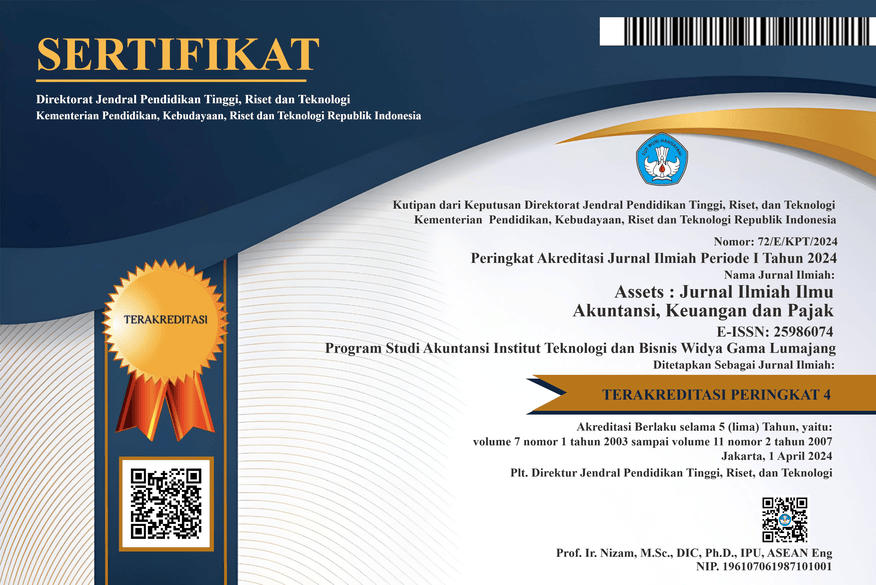Determinan FDI Jepang di ASEAN
DOI:
https://doi.org/10.30741/assets.v2i2.272Keywords:
FDI, ASEAN, GDP, Determinan, JarakAbstract
Bangkitnya krisis ekonomi global membuat pergeseran pusat gravitasi ekonomi global dari negara-negara industrial ke negara berkembang, khususnya negara-negara di wilayah ASEAN. Salah satu penggerak pertumbuhan ekonomi adalah FDI (Foreign Direct Investment) atau investasi langsung asing. ASEAN sendiri merupakan destinasi utama Jepang untuk ekspansi kegiatan bisnis. Maka dari itu perlu adanya analisis determinan FDI untuk mengkaji karakteristik investasi Jepang di ASEAN yang dibantu dengan menggunakan model gravitasi dengan memakai estimasi Pooled Least Square.
Downloads
References
Anwara, S. dan L. Nguyen. 2010. Foreign Direct Investment and Economic Growth in Vietnam. Asia Pacific Business Review 16(1): 183-202.
Aziz, A. dan Makkawi, B. (2011). Relationship between Foreign Direct Investment and Country Population. International Journal of Business and Management, 7(8).
Bakir, A. dan Alfawwaz, T. (2009). Determinants of Foreign Direct Investment in Jordan. Journal International Management Review, 5(2).
Blonigen, B. A. (2005). “ A Review of the Empirical Literature on FDI Determinants”. Atlantic Economic Journal Vol.33.
Calvo et.al. “The ASEAN Free Trade Agreement: Impact on Trade Flows and External Trade Barriers”. Policy Research Working Paper The World Bank Development Research Group Trade and Integration Team, 2009
Chiou Wei, S.Z., Zhu, Z. (2007). A Revisit to The Outward FDI Determinants: Further Evidence from Count Panel Data Models with Fixed Effects. Applied Economics Letters 14, 809–812.
Dogga S., Suresh K., Amaresh . 2014. Trade Openness, Financial Development Index and Economic Growth. Journal of Financial Economic Policy. Vol.6
Hadi, Sutrisno. (2000). Metodologi Research. Yogyakarta: Andi Yogyakarta.
Hsiao,C. 2003. Analysis of Panel Data. Edisi 2. New York: Cambridge Univ. Press.
Hsu et.al (2011). “The Effects of Outward FDI on Home Country Productivity”. Journal of Chinese Economic and Foreign Trade Studies. Vol.4
Ismail, N. W., Smith, P., & Kugler, M. (2009). The Effect of ASEAN Economic Integration on Foreign Direct Investment. Journal of Economic Integration (pp. 385-407).
Iwamoto, Manabu & Nabeshima, Kaoru. (2012). "Can FDI promote export diversification and sophistication of host countries? : dynamic panel system GMM analysis," IDE Discussion Papers 347, Institute of Developing Economies, Japan External Trade Organization (JETRO).
Klimis V., Phuong Nhung T.N. (2016). Economic Openness and Economic Growth : A Cointegration Analysis For ASEAN-5 Countries. Journal of Applied Economics. Vietnam.
Kravis, I.B., Lipsey, R.E. (1982). The Location of Overseas Production and Production for Export by U.S. Multinational Firms. Journal of International Economics, 12, 201–223.
Krugman, Paul R. dan Maurice Obstfeld, (2009),International Economics: Theory and Policy, Eight Edition, Addison-Wesley.
Kurniati, Y.,Prasmuko, A.,Yanifitri. Determinan FDI. Working Paper Bank Indonesia 6: 1-20.
Kwan dan Qiu. 2010. The ASEAN+3 Trading Bloc. Journal of Economic Integration 25(1): 1-31.
Masahito. 2017. ASEAN as an Attractor: How Do Multinationals Look at ASEAN. Economic Research Institute for ASEAN and East Asia.
Milner C, Reed G, Talerngsri P (2004) Foreign direct investment and vertical integration of production by Japanese multinationals in Thailand. J Comp Econ 32(4):805–821
Parasmala, E. (2005). Analisis Hubungan Kausalitas Foreign Direct Investment (FDI) dengan Variabel Makroekonomi di Indonesia. Fakultas Ekonomi dan Manajemen: IPB, Bogor.
Sarwono, J. 2006. Metode Penelitian Kuantitatif dan Kualitatif. Yogyakarta: Graha Ilmu.
Shinta dan Triono. 2015. Pemetaan dan Determinan Intra-ASEAN Foreign Direct Investment (FDI): Studi Kasus Indonesia. Working Paper Bank Indonesia.
Shujiro dan Waseda. 2002. Japanese Foreign Direct Investment in East Asia with Particular Focus on ASEAN4. Conference on Foreign Direct Investment: Opportunities and Challenges for Cambodia, Laos, and Vietnam.
Tamirisa, T., Natalia.”Exchange and Capital Controls as Barriers to Trade”. IMF working paper, 1999.
Tinbergen, J. (1962). Sharing the Word Economy : Suggestions for an International Economic Policy. Twentieth Century Fund : New York.
Yang, Ivy dan Y. J. Handayanto. (2013). Free Trade Agreement in East Asia. Social Transformation Toward sustainable Community, 57-64.
Zarzoso, Martines., Inmaculada.” Gravity Model: An Application to Trade Between Regional Blocs”, Atlantic Economic Journal, 2003.
Japan Trade and Investment Statistical, 2017
Japan Bank for International Cooperation, 2010
Japan Bank for International Cooperation, 2017
Mizuho Economic Outlook & Analysis, 2017
World Development Indicator. 201









